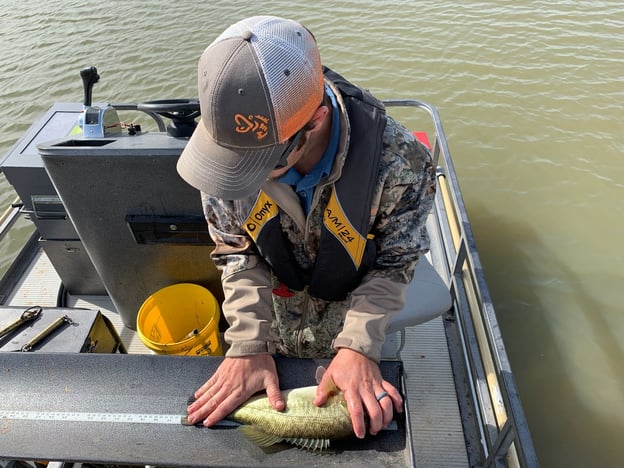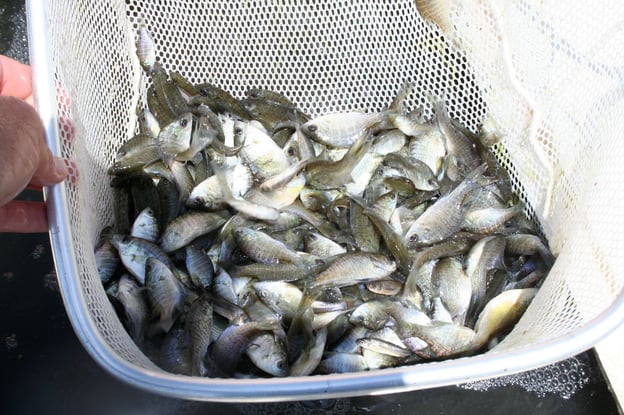Just like any other long term projects that are composed of living organisms, ponds and lakes require year round management.
To make the best use of your time and effort invested into the management of your pond or lake, there are certain times of the year to carry out various tactics to get the best benefits.
It's just like your garden - you wouldn’t plant your tomatoes in the fall and expect them to put on fruit mid-Winter. Matching the management tactic to the proper season is crucial.
Winter Pond Management Guidelines
Winter falls both into the end of a management year and the beginning of a new one, so let's start here.
What Makes Winter a Good Time for Pond Habitat Improvement?
At this point in the season your predator species are primarily dormant and not actively hunting or putting energy resources into growth, which explains why they are harder to catch. In addition to your predator species, the aquatic vegetation in your fishery is dormant and in most cases has died off for the year.
This makes the Winter season a perfect time to carry out habitat improvement projects.
Winter Pond Tactics to Prep for Spring Fishing
This is the perfect time to make sure your lake is ready to deliver a booming Spring! Maintaining feeders, updating submerged habitat and planting real or artificial vegetation is much easier this time of year.
The water is typically clearer and with the vegetation gone you can place new habitat structures without them getting in the way. Another great management tactic for this time of year is to make sure your fish feeders are in proper working order, and the batteries are charged, the timers are set and ready for the growing season.
Protecting Your Pond Fish from Cormorants
Unfortunately, migrating Cormorants often start showing up this time of year as well and begin predating on your forage populations.
This species of waterfowl is federally protected, so beyond non-lethal means of harassing them off your pond or lake, the only other way to protect your fishery is to ensure there is adequate availability of complex habitat to protect your fish.
In short, Winter is primarily a time of repair and reflection, with a bit of habitat improvement thrown in.
Take Advantage of New Spring Growth for Pond Success
Spring is the time of the year when your pond comes alive again, and the point of the year where the management is typically the heaviest. At this point in the season you are laying the groundwork for the year to come.
Crucial Pond Management Practices for Spring
Spring requires pond owners to pay close attention to several factors in order to help the growing period deliver the best results possible.
Lake and Pond owners should use Spring for:
- Fertilizer applications
- Vegetation monitoring/ treatment
- Beginning the seasonal harvest of predators
- Restarting the feeding regimen for forage fish
All of these tasks should be started or carried out at this point in the season to ensure your pond is getting all its needs.

This is the time of the year that reproduction begins in the fishery. Typically speaking, your Crappie and Bass are the first species to spawn, then followed by Shad and Catfish, and finally your Bluegill spawn throughout the Spring, Summer and Fall.
Harvest Fish for Your Lake’s Environmental Balance
With all of these newly introduced individuals, this is when harvest efforts should begin to help reduce loss to predation and better allocate resources throughout the remainder of the season.
Grass and Aquatic Vegetation Control
Getting ahead of aquatic vegetation at this point in the year helps to gain early control of the situation and reduce input costs for management/control throughout the remainder of the year.
Spring is a Great Time for an Electrofishing Survey
This is also an excellent time to have an Electrofishing survey performed on your fishery to evaluate the population dynamics. This can help to point out key issues that can be corrected early in the growing season before than can compound into greater problems.

Summer Pond Maintenance Is Crucial to Prevent Fish Kills
Summer turns into more of a maintenance season with key emphasis placed on vegetation control and dissolved oxygen monitoring.
It's at this point in the season that the most damage can occur to your fishery in the shortest amount of time. This is when water temperatures are at their highest, which in turn leads to pond stratification and low dissolved oxygen availability.
Because of this, Bass activity slows down, not quite to the extent of the Winter period, but to the same effect, focus is put on maintenance instead of growth.
Why is Summer a Dangerous Period for Small Ponds and Lakes?
These conditions can lead to an exponentially more severe situation if there are large expanses of aquatic vegetation present.
Contrary to popular belief, vegetation can use the available oxygen in the water for its own needs, rather than the oxygen being available for your fish. During low light conditions, vegetation utilizes the dissolved oxygen for cellular respiration instead of producing it through photosynthesis.
This is why getting ahead of vegetation in the spring season is so important.
Smaller Ponds are at Greater Risk of Oxygen Loss from Vegetation
This is especially true for smaller fisheries less than 3 acres. Larger lakes, greater than 3-5 acres, aren’t as prone to this situation because of the increased surface areas and greater wave action from the wind allowing for greater diffusion of atmospheric oxygen.
Warnings Signs of Low Dissolved Oxygen Content in Your Lake
Important signs to watch for to determine if your pond or lake has a low dissolved oxygen level and at risk for a fish kill is fish “piping” or gulping for air at the surface right at sun-up.
Aerating Fountains Can Help Increase Dissolved Oxygen
Installing emergency aeration equipment such as surface aerators, aerating fountains or bottom based diffusers can help limit your risk for an oxygen depletion at this point in the season.

Fall Transition Begins Your Cold Weather Pond Preparation
Fall is typically when fish activity picks back up again.
Bass begin to increase consumption to put on more condition/energy stores to make it through the Winter months. Aquatic vegetation growth begins to slow down as water temperatures begin to cool.
It’s at this point in the season that yearly requirements for predator harvests and supplemental stocking need to be finalized to ensure that increased efforts aren’t needed for next year.
Utilize a Second Electrofishing Survey to Determine The Year’s Success!
This is another great time of year to have an Electrofishing survey done. Performing a survey at this time of the year helps to evaluate the recruitment of newly hatched individuals from the previous spring, as well as the growth of your predator/prey ratio.

As you can see, there is always something that can be done no matter the season. However, focusing on certain portions of the management plan during the correct season can go a long way in spending less time trying to recover your fishery and more time enjoying it.
Trust Pond King, Inc. for All Your Pond and Lake Management Needs
If you have any other questions about the seasonality of your pond management strategies, or would like suggestions on how to improve the effectiveness of your management plan feel free to contact us anytime or call to speak to one of our Pond King Pros!
See y’all down at the pond!




